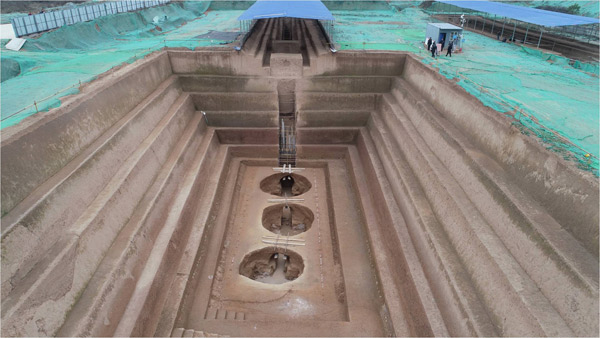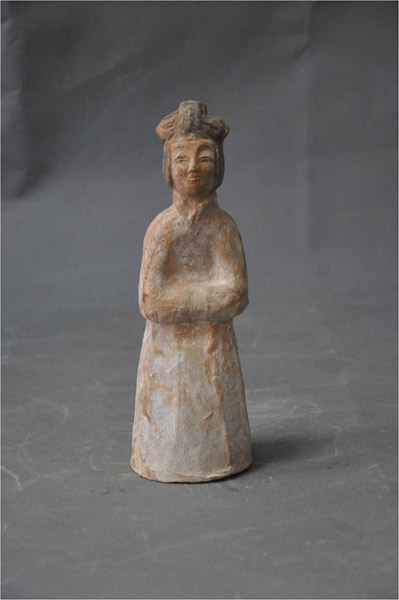Information
Mixed culture

An unearthed Sixteen Kingdoms gravesite shows links from the period to present-day Xi'an, Wang Kaihao reports.
In the fourth century AD, when the Roman Empire was suffering from turmoil, imperial China had its own share of chaos.
From 304 to 439, dozens of states established by various ethnic groups existed all across the north and southwest of China and fought one another, while the southeast was relatively stable under the Eastern Jin Dynasty (317-420) of Han rulers. Some of these short-lived states emerged as regional powers, during a time known as the Sixteen Kingdoms period.
Most relics from that time were destroyed in wars later. Some states remained only in historical records without any archaeological findings.
In Xi'an, Shaanxi province, a large gravesite from the Sixteen States period was recently unearthed. It will probably provide crucial evidence to study that gloomy page of history.
"So far, this is the biggest and highest-level graveyard found from the Sixteen Kingdoms period," Xin Long, an archaeologist from the Xi'an Academy of Cultural Heritage Preservation and Archaeology, told media in Beijing last week.
The excavation started in January 2018 after the site was accidentally found during the construction of a new residential compound on the southern outskirts of Xi'an. The first phase of fieldwork was completed in April.
Two main tombs were found at the site. The bigger one, 18.5 meters underground, has a 60-meter-long passage leading to three coffin chambers, while the tomb passage of the smaller one is 54 meters long.

"We think they are the mausoleums of a king and his queen, but further studies are needed to make sure of the occupants' identities," Xin says.
"The layout of the tombs reflects typical styles of high-level residents of that time. The tombs' occupants probably had a house with three yards in their lifetimes as well."
The king may have wanted to enjoy an equally cozy existence even after death, which is why the tomb complex has front doors, columns and even windows made of clay. The exquisite frescoes found in the coffin chambers are still being restored by archaeologists. Images of deities and warriors are also visible.
Xin says five of the 16 kingdoms once existed on the plains on which Xi'an is also located. But no direct evidence like an epitaph has been found yet to connect the site to any specific state. However, based on studies of 68 unearthed funerary objects, including clay figurines, gold foils, copper coins and silver decorations, Xin suggests the tombs are from the Former Qin (351-394) or Later Qin (384-417) periods.
The two kingdoms have the same name but are distinguished by historians-Former Qin, the strongest among the 16 kingdoms, which briefly united northern China, was established by the Di ethnic group, possibly early Tibetans. Later Qin was founded by ancestors of today's Qiang ethnic group. Both kingdoms once had their capitals in Xi'an, known as Chang'an in ancient times.

Xin says the clay figurines offer references for studies into the Sixteen Kingdoms period, but they also compose the most confusing part. For example, while other unearthed artifacts indicate the tomb was dug during the Former Qin because they look similar to those in previously found tombs of that kingdom, some horse figurines don't have stirrups while artifacts from other contemporaneous tombs do. Academics consider the earliest use of stirrups in warfare to have taken place in the Sixteen Kingdoms period. It gradually expanded westward and changed military history.
Xin says he expects comparative studies to give new ideas tracing its origins and development.
Pottery discovered at the tombs, such as green-glazed pots, show typical styles from southeastern China at the time, and the aesthetics of Chang'an are exhibited by hair buns.
"These artifacts strongly showcase their time," Zhu Yanshi, a researcher at the Institute of Archaeology of the Chinese Academy of Social Sciences, tells China Daily.
"That is a time when the north and south communicated in depth, and different cultures mixed."
Zhu says horse-riding nomadic people during the Sixteen Kingdoms period tried to establish their own kingdoms in central China and preferred to set their capitals in Chang'an and Luoyang. Both were metropolises during the Han (202 BC-220 AD) and Tang (618-907) dynasties.

The newly found gravesite also shows typical Han cultural motifs incorporated in the designs rather than purely nomadic styles.
"If one of the tomb's occupants is a king, the studies will give us a general picture of how society and the fine arts developed at the time," Zhu says, adding that royals were pioneers of trends.
Separately, a comprehensive database of ancient Chinese nomadic peoples' DNA is being established to trace their origins, but relevant archaeological materials of the Di and Qiang groups are scant. As bones were found in the tombs in Xi'an, Zhu says related work can be built upon step by step.
"Speaking of the history of Xi'an, people will always think of the Han and Tang dynasties," Song Xinchao, deputy director of the National Cultural Heritage Administration, says.
"With this, people are being reminded of its important status in the Sixteen Kingdoms period."
The tomb complex in Xi'an was excavated as part of the Archaeology China project launched by the administration.
"The project uses the archaeological approach to establish a framework of knowledge," Song says.
"How did the Chinese civilization begin? How did different cultures mix to form a united country? These are questions we try to answer."
Contact the writer at wangkaihao@chinadaily.com.cn
Category: English
News
Information
Key words:
